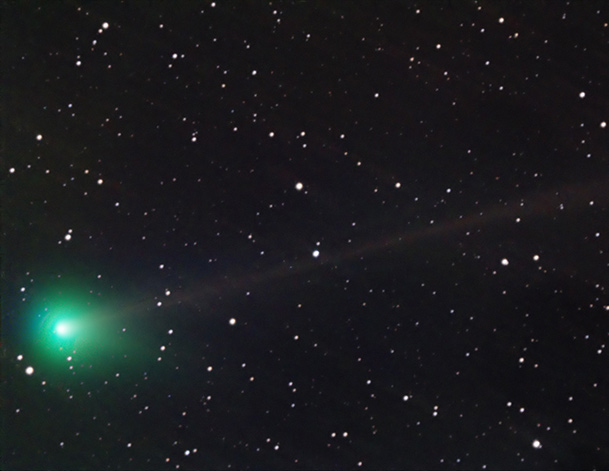Create a free profile to get unlimited access to exclusive videos, sweepstakes, and more!
Actually, if you're a comet, it *is* easy being green
But why is it green?

Yesterday, I wrote about the comet 2009 R1 McNaught, which is currently in the extreme northern sky in the early morning. By coincidence, just hours after posting it, I got an email from the amateur astronomer Anthony Ayiomamitis (the same guy who took the very cool picture of the ISS and Jupiter in the daytime), who sent me this picture of the comet he took in Greece at just around the same time that post went live:
Wow, very pretty! The solid part of the comet, called the nucleus, is far smaller than a single pixel in this image, since the comet was more than 175 million km (110 million miles) away when he took this shot. The nucleus of even a huge comet is only a few dozen km across, so at that great distance is just a tiny dot. Anthony has details on his observations on his McNaught page.
The comet looks huge -- and the fuzzy part can be bigger than planets! -- because what you're seeing is gas expanding away from the nucleus. Far from the Sun that gas is frozen, and the comet is solid. But heat it up and that ice turns into a gas, creating the comet's coma (Latin for hair). In that gas methane, water, ammonia, and lots of other things, many of which are pretty nasty.
But why is it green?
Ah, that's a good question (I'm glad I asked it!) and takes just a little bit of background.
When the gas suffusing out from the nucleus gets hit by ultraviolet light it becomes ionized; one or more electrons get stripped off the atoms. That's important because the Sun is blowing a wind of subatomic particles called the solar wind, and as it moves out from the Sun it carries a magnetic field with it. This field interacts with the comet's ions in the coma, shearing them away (this process is pretty complicated, and not completely understood). The solar wind is moving far, far faster than the comet (many hundreds of km/sec, versus maybe just a few dozen), so the ion tail points straight away from the Sun. As far as the solar wind cares, the comet is just standing still.
And that brings us to the comet's verdant glow. That green color is real, and not just from the way the picture was made! And it's the same reason a neon sign glows. When you have an ionized atom or molecule (or just an excited one, with an electron bumped into a higher energy state so that it can fall back down), the electron can recombine with its parent. When it does, it gives off light. The color of the light depends very strongly on the type of atom or molecule. Excited hydrogen glows red, for example, which is why so many gas clouds in deep space glow that color.
In a comet, diatomic carbon (C2) gas glows characteristically green, which is why some comets, like McNaught, are green. And I wouldn't blame you if you thought that these comets must be mostly made of that molecule, since the comet is so green. But, as with everything in science, there's more going on ...
Some atoms and molecules emit more strongly than others. Under the same circumstances, a kilo of C2 would glow much more fiercely than a kilo of, say, hydrogen. It depends on some relatively complicated quantum physics -- forgive me if I leave off the details -- but you can think of it as one person who can yell louder than a bunch of other people combined. That one person dominates the emitted sound, even though there are lots of people in the room. It's the same in the comet: C2 is a strong emitter, its presence dominates the color we see. That's not the case for every comet (some may be deficient in that molecule), but it's certainly true for McNaught; lots of observers are reporting its strongly blue-green color.
I've seen quite a few green comets in my time, and while it's a little odd to see something glowing a ghostly hue like that in the sky, it's always lovely. This comet promises to be a good one, so if you get a chance, go out and hunt it down.
Correction Jan. 2, 2015: I originally wrote that cyanogen—(CN)2—was also a strong green emitter. This is also widely quoted on websites and other articles, and has been for many years. However, cyanogen emits mostly in the violet part of the spectrum, at 387 nanometers, which is nearly in the ultraviolet! There is also some weak emission at 420 nm and in the infrared as well, but nothing in the green. It's unclear where this error got started, but however it did, cyanogen does not contribute to the green color of comets. My thanks to Frank Suits for pointing this out to me; you can read more about this at the Cloudy Nights forum.



























